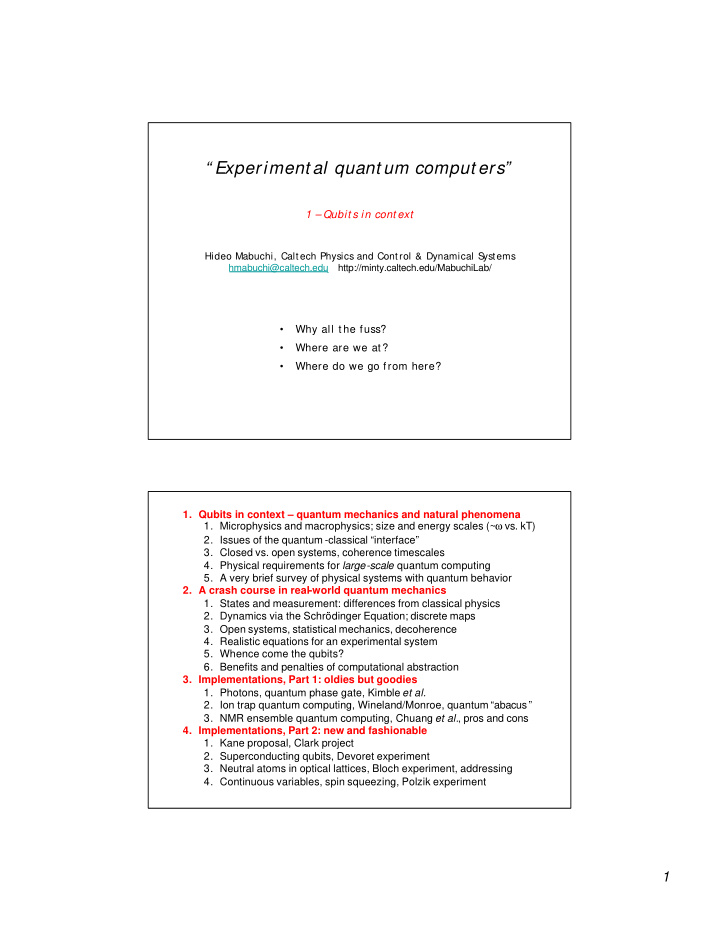



“ Experiment al quant um comput ers” or, t he secret lif e of experiment al physicist s 1 – Qubit s in cont ext Hideo Mabuchi, Caltech Physics and Control & Dynamical S ystems hmabuchi@caltech.edu http://minty.caltech.edu/MabuchiLab/ • Why all t he fuss? • Where are we at? • Where do we go from here? 1. Qubits in context – quantum mechanics and natural phenomena 1. Microphysics and macrophysics; size and energy scales ( ~ ω vs. kT) 2. Issues of the quantum -classical “interface” 3. Closed vs. open systems, coherence timescales 4. Physical requirements for large-scale quantum computing 5. A very brief survey of physical systems with quantum behavior 2. A crash course in real-world quantum mechanics 1. States and measurement: differences from classical physics 2. Dynamics via the Schrödinger Equation; discrete maps 3. Open systems, statistical mechanics, decoherence 4. Realistic equations for an experimental system 5. Whence come the qubits? 6. Benefits and penalties of computational abstraction 3. Implementations, Part 1: oldies but goodies 1. Photons, quantum phase gate, Kimble et al. 2. Ion trap quantum computing, Wineland/Monroe, quantum “abacus” 3. NMR ensemble quantum computing, Chuang et al. , pros and cons 4. Implementations, Part 2: new and fashionable 1. Kane proposal, Clark project 2. Superconducting qubits, Devoret experiment 3. Neutral atoms in optical lattices, Bloch experiment, addressing 4. Continuous variables, spin squeezing, Polzik experiment 1
• computer microchips • biotechnology d n a i d e s l l e c f u o i f s n s l s e l n a c m s c l s i b i a m n y o l l t e r c o g i t o o a c i o b c t f a micro macro Quantum Classical Classical harmonic oscillat or • point particle in quadratic potential • “state” $ {x(t),p(t)} • oscillation frequency ω =[k/m] 1/2 • e.g. mass on a spring, rolling marble, … 2
Microphysics and macrophysics, size and energy scales • We can identify quantum and classical limits in size, energy • Intermediate regime – the regime of interest – is relatively murky • ~ ω indicates energy scale of quantization • kT is a thermal energy spread • ~ ω /kT is a rough figure-or-merit for “quantumness” Issues of the quantum— classical “ int erface” • Notion of quantum state, quantum phenomenology • Incompatibility with classical phenomenology • The measurement “problem,” interpretations thereof • Necessity (and difficulty!) of preserving “un-collapsed” states • Q-C transition is robust ) Q. computing requires pathological configurations! 3
Closed vs. open systems, coherence timescales • Conservation laws, reversibility imply leakage of information » measurement • Timescale for imprinting » decoherence timescale Physical requirements for large-scale quantum computing • Recall, benefits of quantum computing emerge “asymptotically” • Physical system with controllable and observable (?) sub-space • “Long” coherence times • Scalability • Physical extensibility • Mechanism for suppression of “errors” 4
Physical systems with quantum “ behavior,” and technology • Coherent superposition, interference: interferometers, atomic clocks • Tunneling: alpha decay, solid-state tunnel junctions (intentional, or not!) • Superconductors: persistent currents, SQUID magnetometers • Superfluids: liquid helium, degenerate atomic gases • Entanglement: Bell Inequality violations, teleportation Interferometers (double-slit) 5
6
Recommend
More recommend